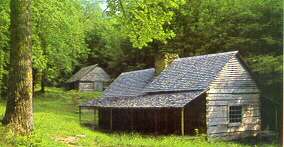Echoes From The Past
By JUDY MAUPIN
*- Echoes From the Past
(A Column of historical and genealogical anecdotes, stories and family notes.)
Calloway County, Ky.
History of Marshall County
August 8, 1981
This week we are continuing the
short histories of the counties in the
Jackson Purchase.
Marshall County was named for Chief Justice John Marshall, who served on the United States Supreme Court many years ago. The boundaries of the county are: the Tennessee River (now Kentucky Lake) on the north and east; Calloway County on the south, and parts of Graves and McCracken County on the west.
As we noted last week, Marshall County was originally the northern half of Calloway County, until it was divided in June, 1842. From that time on, it has been autonomous. Marshall County covers an area of 328 square miles, or 209,920 acres.
As with Calloway County, its main waterways are the branches of the Clarks' River, although in Marshall County there are three: East, West and Middle. Jonathan Creek is another stream flowing through the county, but since the formation of Kentucky Lake in 1941, it is similar to Blood River in Calloway County, because it now is an arm of Kentucky Lake.
There seems to be a bit of uncertainty about when the first settlers came to Marshall County. The first permanent settlement was on Wade's Creek, about a mile north of Wadesboro, in 1819, by James Stewart. Another early settler was Isaac Johnson who came from Eddyville about the same time as Stewart.
James Brien came to Marshall County a year or two later and set up his trade of blacksmith in the new county, then Calloway. He founded the town of Briensburg.
Evidently the first, or at least one of the earliest religious groups in the county was begun by Reverend Henry Darnall, who came from Caldwell County about 1820 and founded the Soldier Creek Baptist Church in a little log cabin.
In the early days of the Jackson Purchase, the church played a very prominent role in the settlers' lives. This is true even today in the lives of
many Kentuckians, but in those days, there were no other places to gather with friends, no other forms of entertainment to compete with religion. As Battle and Perrin noted, "No class of people appreciate more fully the preached word than the early settlers of a country."
Those were the days of the circuit rider, when ministers spent most of their time on horseback, riding from one tiny settlement to another, holding meetings in homes and churches whenever they could get there, be it Sunday or not. Among these early preachers were Henry Darnall, Absalom Copeland, James Bell, and Hugh and Ambrose Gilbert. Morgan. Williams was another early preacher at Wadesboro.
Benton was decided upon for the county seat of Marshall County and the first structure to be built on the court square was a log jail, followed by a log courthouse built about 1843, built by Francis Clayton. The town was named for Senator Thomas Hart Benton of Missouri.
During the Civil War, Marshall County had sons on both sides of the conflict, although it, like the rest of the Jackson Purchase, leaned heavily toward the Southern Cause. Two Confederate companies of the Third Kentucky Infantry were organized there, one led by Alfred Johnston and one by Crittenden Edwards.
These companies served throughout the war, playing an active part in the Battle of Shiloh. No mention was made of any skirmishes, major or minor, taking part within the boundaries of the county itself.
Some of the settlements within Marshall County are (or were) Birmingham, (now extinct, since the formation of Kentucky Lake), Briensburg, Calvert City, the Gilbertsville. It has been an active county in growth since its early days and is now the site of much industry, especially at Calvert City.
Next week, we will take a look at the early days of Graves County, Calloway County's neighbor to the west.

